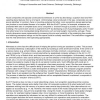Free Online Productivity Tools
i2Speak
i2Symbol
i2OCR
iTex2Img
iWeb2Print
iWeb2Shot
i2Type
iPdf2Split
iPdf2Merge
i2Bopomofo
i2Arabic
i2Style
i2Image
i2PDF
iLatex2Rtf
Sci2ools
FGR
2006
IEEE
2006
IEEE
Adding Holistic Dimensions to a Facial Composite System
Facial composites are typically constructed by witnesses to crime by describing a suspect's face and then selecting facial features from a kit of parts. Unfortunately, when produced in this way, composites are very poorly identified. In contrast, there is mounting evidence that other, more recognition−based approaches can produce a much better likeness of a suspect. With the EvoFIT system, for example, witnesses are presented with sets of complete faces and a composite is `evolved' through a process of selection and breeding. The current work serves to augment EvoFIT by developing a set of psychologically useful `knobs' that allow faces to be manipulated along dimensions such as facial weight, masculinity, and age. These holistic dimensions were implemented by increasing the size and variability of the underlying face model and obtaining perceptual ratings so that the space could be suitably vectorised. Two evaluations suggested that the new dimensions were operating ...
| Added | 11 Jun 2010 |
| Updated | 11 Jun 2010 |
| Type | Conference |
| Year | 2006 |
| Where | FGR |
| Authors | Charlie D. Frowd, Vicki Bruce, Alex H. McIntyre, Peter J. B. Hancock |
Comments (0)

